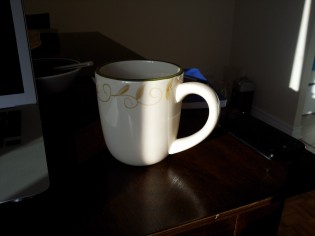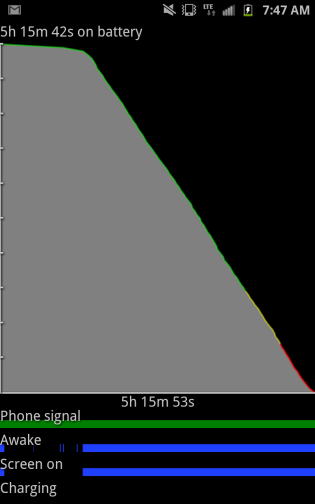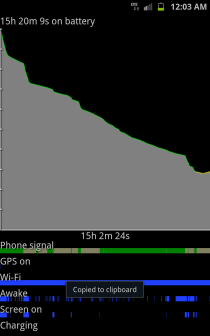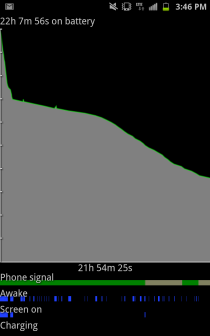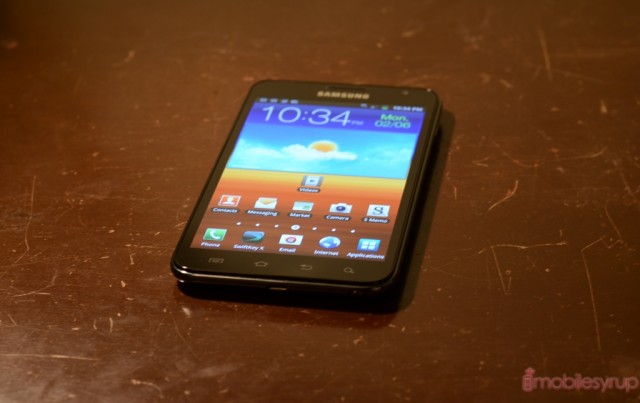
Previously unknown to common man, Samsung has created its own multi-category device in the Galaxy Note. Either the biggest phone or the smallest tablet I’ve ever used, the Note sits on the edge of madness, but manages to be neither absurd nor unreasonable.
The high-resolution 5.3-inch screen and LTE capabilities are kept under control by a massive 2500mAh battery, while its Wacom-powered S-Pen tries to be more than just a built-in stylus. In Part One of this review, we’ll take you on a hardware tour to see if this big phone is really a big deal.

Specs:
– Android 2.3.6 Gingerbread with TouchWIZ 4
– 5.3-inch 1280 x 800 pixel HD Super AMOLED display with Gorilla Glass
– 1.5Ghz dual-core Snapdragon APQ8060 processor w/ Adreno 220 GPU
– 1GB RAM / 16GB internal storage (expandable to 48GB)
– 8MP back camera / 2MP front camera
– 1080p video capabilities
– Dual-band WiFi (b/g/n), Bluetooth 3.0, A-GPS, NFC
– HSPA 850/1900/2100Mhz, LTE 700/1700/2100Mhz
– HSPA 21Mbps, LTE 75Mbps (theoretical maximum)
– 146.8 x 83 x 9.7 mm
– 178g
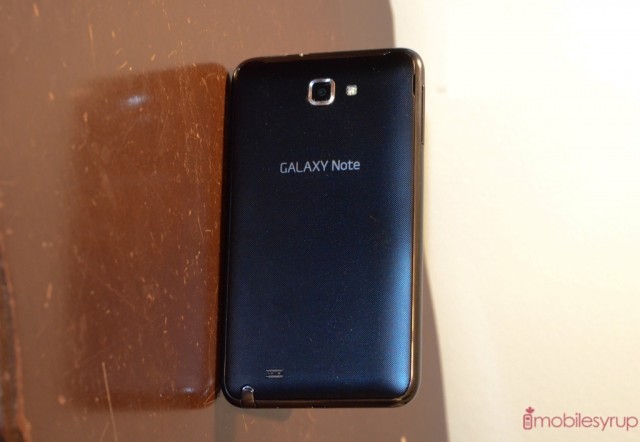
Part Phone, Part Tablet
Here is a tale of a device too big to be a phone and too small to be a tablet. Hence, a “phablet.” While the Note maintains many of the stylings that debuted with the original Galaxy S II last year, it would be safer to say that it is a giant Galaxy S II LTE, since its back cover and faux-metal chrome border pays tribute to its smaller cousin.
While made entirely of plastic, the quality of the materials has been improved considerably. Though much of this can be attributed to the mere size of the device, Samsung has not overlooked the need for a thicker battery cover, nor a more sound, creak-free body.
Like any Samsung, the power button is on the right while the volume rocker remains to the left, with a headphone jack on top and a microUSB port on the bottom. Eschewing the front-side hardware button for separate capacitive buttons was a choice likely necessitated by AT&T, since all its Android phones have dedicated search buttons, but I’m not too upset about the loss. Over time I found the Galaxy S II’s physical hardware button to give trouble, refusing to register a click that wasn’t exactly centred. This format eliminates that issue but also crowds what could have been a nicer layout. I am of the opinion that Android phones should not have dedicated search buttons, and an increasing number of OEMs seem to be agreeing with me.

The Note is surprisingly comfortable to hold despite its massive 147mm width, likely because it is under 10mm thick. It will fit into most pants pockets, though it may cause trouble in a tighter pair of jeans. Using the Note with one hand is decidedly more difficult: without massive thumbs and a double-jointed nature it won’t be possible to reach the top left of the screen without some serious maneuvering. This is most definitely a two-handed machine, and not just for typing. You’ll find it more comfortable to grab the Note between forefinger and thumb, as if you were holding a golf club, though this means your thumb will often be resting on the right (or left) side of the screen.
Using the Note as a phone means coming to terms with either looking like you have an absurdly small head, or investing in a good Bluetooth headset. There is no getting around this: your hand will cramp and feel uncomfortable unless it is large enough to wrap entirely around the device. Nevertheless, Samsung and carriers alike are marketing the Note as a smartphone, and for good reason.
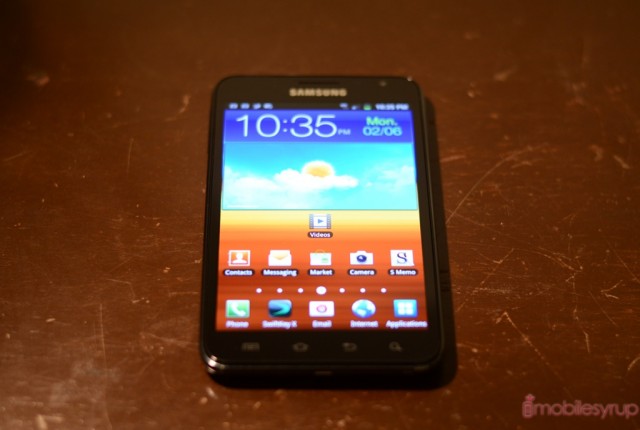
Usability & Display
As I said, this is a two-handed device. But with such a large screen comes a significantly larger usable area, and Android is nothing if not adaptable. Instead of a 4×5 grid of icons, the Note’s TouchWIZ launcher is 5×5, expanding horizontally by one, and supports a wide range of larger widgets as a result.
The first thing you’ll notice when turning on the display is the ridiculous 284dpi pixel density; though slightly less than the Galaxy Nexus, the Note is no less vivid. With a notebook-like resolution of 1280×800 pixels, Samsung chose to make everything crisper instead of smaller. The usable area is greater, yes, but you’ll mostly notice the extremely sharp text and endless viewing angles. Like all Samsung AMOLED products, colours are vibrant to the point of saturation, while blacks are deep as the sea. Whites seem far more accurate than in previous Super AMOLED variants; even at half brightness they lack the blue tint of their lower-resolution peers.
Its screen is also sufficiently bright, matching the Galaxy Nexus in overall luminance. It does not compare to most Super LCD displays, but for daily indoor use the Note’s screen excels. Outdoors in direct sunlight I found the screen to be rather muted but still navigable.
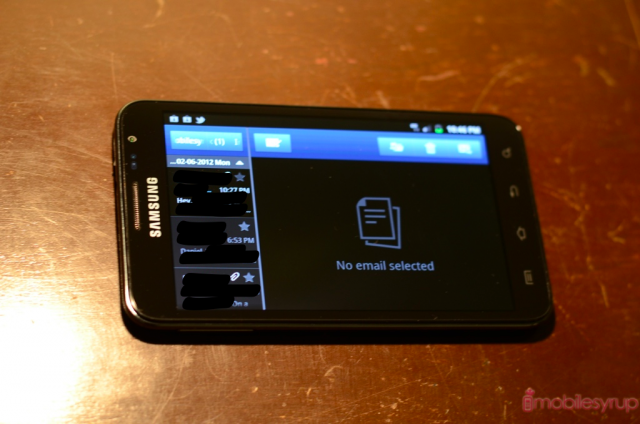
The added screen resolution coupled with the larger screen size makes the Galaxy Note perfect for three things: web browsing, gaming and media consumption. Though the aspect ratio is slightly less “wide” than the Galaxy Nexus (16:10 compared to 16:9) it suits landscape use very well; unlike the more cumbersome 7-inch tablets of yore, the Note is very easy to cradle in one hand, and has enough of a bezel to avoid encroaching on the screen space. While it is possible to use a thumb to reach diagonally across much of the screen, there is little chance of that same hand holding and navigating the Android UI alone. This will become even more wearisome in Android 4.0 as many of Google’s own apps rely on a top-left “back” area that doesn’t always correlate to the action of the back button underneath the screen.
Typing on the Galaxy Note should be fantastic — big, sharp keys and plenty of room — but for whatever reason the stock Samsung keyboard isn’t as responsive as I’d like. After a couple sentences, the keyboard was having trouble keeping up with me. Thankfully the Note comes preloaded with Swype, and there are plenty of other fantastic third-party keyboards in the Marketplace like Swiftkey X, Smart Keyboard Pro and Thumb Keyboard.
The only negative thing I can say about the screen on the Galaxy Note is that it uses the PenTile matrix in its pixel makeup, meaning that instead of a full red/green/blue palette, it interleaves a number of smaller green pixels between the regular-sized blue and red. This creates an aliased look to text and disrupts the uniformity of certain colours. Though not nearly as noticeable as on the Motorola RAZR or earlier lower-resolution models, due to the size of the screen it is easier to see individual pixels.
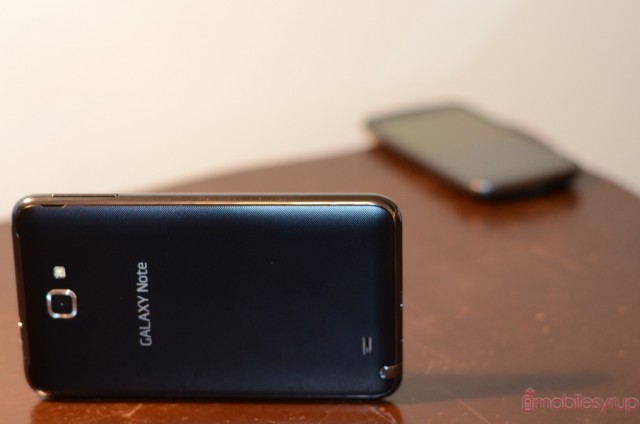
Performance
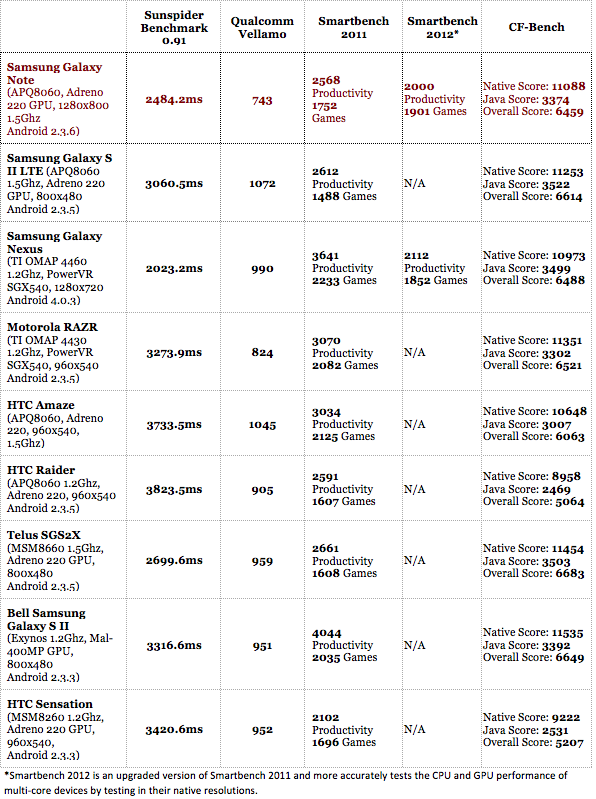
Unlike the international HSPA+ version of the Galaxy Note, which uses a 1.4Ghz variant of the blazing fast Exynos 4210 processor, our LTE version uses sticks with the Qualcomm Snapdragon chip. First used mid-2011 in the HTC Sensation at 1.2Ghz, it later got a speed bump to 1.5Ghz and has powered everything from the Galaxy S II LTE to the Galaxy Tab 8.9 LTE.
Samsung was hamstrung into using this comparably slower SoC because it is the only one currently compatible die-compatible with Qualcomm’s own MDM9600 LTE chipset. While still a perfectly fast solution, the relatively slow GPU speeds are being met by the high-definition screen. As you can see by the benchmark results, when tested at its native resolution (Vellamo, Smartbench 2012) the Galaxy Note suffers a nasty performance hit. Resolution-agnostic tests, or ones that are done at WVGA resolution like Smartbench 2011, exhibit almost exactly the same performance as the Galaxy S II LTE, both of which are sorely beaten by the original Galaxy S II with the Exynos processor.
Most users won’t notice a performance hit between the original Galaxy S II and the Galaxy Note, or will be too blinded by the insane LTE speeds and gorgeous HD screen to notice, but it’s hard to avoid the fact that a brand new device being released at the beginning of 2012 is using the same processor as the Galaxy S 2 X released last summer. It’s the same issue I had with the Samsung Infuse 4G, which used an overclocked Hummingbird chip over a year after the release of the Galaxy S i9000.
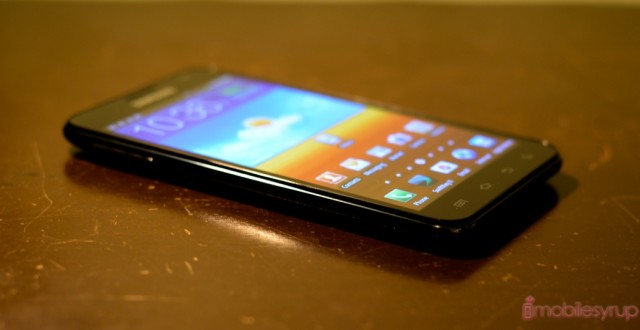
Samsung loaded several of its recent ads, all encoded at 720p, and they looked absolutely amazing. The Snapdragon processor had no issues keeping up with the x.264-encoded clips, and frame rates stayed at a leisurely 24fps. General UI performance, too, was pretty snappy, with smooth window transitions and quick app load speeds.
Since the Note feels more like a small tablet than an oversized phone, I tried to use it as such: I watched a lot of live TV using the new Bell Mobile TV app, played a bunch of 3D games (Sleepy Jack! GTA 3!), loaded a ton of desktop-heavy web pages, read a chapter in Google Books, answered a few emails or tweets, and took a few notes with the S-Pen. I never quite shook the fact that what I could be doing was either better suited for a larger tablet screen, or would be less cumbersome on a smaller phone screen.
Performance-wise, though, it was rare for me to bemoan the Note’s internals as being insufficient. Being able to play back 720p content natively is fantastic, but the processor couldn’t keep up with anything of a higher resolution, namely 1080p movie trailers. Most games played flawlessly, including the very graphics-intensive Riptide GP, though frame rates did crawl in certain areas of GTA 3’s Liberty City. My issue with the Note is more philosophical than practical: for a device this expensive and top-of-the-line, there is no excuse to not include the best hardware in the business. Tegra 3 trounces the Snapdragon S3 across the board, and with the release of Qualcomm’s Snapdragon S4 in mere weeks, the Note’s superior performance will shortly be surpassed.
Camera
The Note has a fantastic 8MP camera that, much like the Galaxy S II, is fast and colour accurate. In many ways the sensor equals that of the iPhone 4S, which is considered to have the best optics in the business. Even in low light the Note takes great stills, and when needed the flash does not overpower.
As you can see from the sample photos, there is plenty of detail and rich colour, though they do come at the expense of some artificial sharpness and grain. Holding the Note to take photos is a little awkward since cradling it with one hand between your thumb and middle finger, using your forefinger to take the shot, is difficult unless you have a second hand to support the left side. Supporting the bottom right side in you palm, supporting the top with your forefinger and using your thumb to take the photo is a bit easier for one-handed operation, but I always felt like the Note was about to drop out of my hand unless I held it steady with another.
The camera UI is unchanged from previous iterations of Gingerbread, which makes it minimal and simple. The right-side virtual shutter button, when held halfway down, will correct the white balance and focus, completing the shot when you take your finger off the trigger. It’s a good system that works most of the time. Unfortunately the screen itself cannot seem to keep up; the image on the screen only simulates the shutter half a second to a second later, which is disorienting. Nevertheless, you’ll be happy with the Note for still photos.
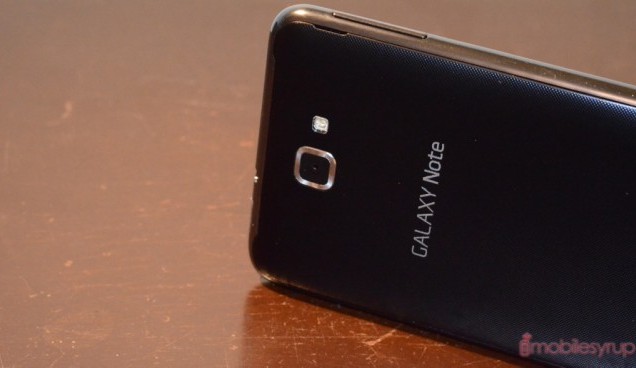
The Note comes with a comprehensive editor, too: once in the Gallery app you can crop, resize, rotate, add filters to, and share your photos to various apps. You can also use the S-Pen to draw on, or annotate, your photos, something I found increasingly useful as I thought of funny things to do with photos of cats.
The Note also takes 1080p video at 30fps, which looks just as great today as it did a 8 months ago on the Galaxy S II. Smooth is one story, but there is also minimal motion blur to be found. The lens adjusts well to changes in lighting, and Samsung employs some fantastic image stabilization technology to keep the results looking far less wobbly than my hands would suggest.
As with all recent Samsung devices, the 2MP front-facing camera is not only of higher quality than most of its peers, but using it on the Galaxy Note it’s actually more fun. As more apps like Skype and Google+ support video chats, a high-resolution front facing camera is going to be increasingly important. The Note works extremely well as a video chat solution since not only does recipient look great, but that little box in which you can see yourself is actually more than just a thumbnail.
Battery Life
(Left: Results of video looping tests with LTE on / Middle: Example of average daily use, WiFi on / Right: Example of mostly-idle day, WiFi off)
Though there is a 2500mAh battery in the Galaxy Note, we must keep two important things in consideration. First, the 5.3″ 1280×800 pixel screen is a huge power draw, with over double the pixels of the Galaxy S II (1,024,000 vs 384,000). Second, the LTE chip inside the Galaxy Note is an independent, high-draw chip as it is not built into the CPU itself like most HSPA+ solutions. As a result, the Galaxy Note has the potential for largely the same or only slightly higher battery life than the average Android smartphone running Gingerbread.
However, since the average user doesn’t keep his or her screen on for more than a couple hours a day, nor watch movies on repeat until the battery dies, it’s safe to say the Note will last longer than your average smartphone. Whereas I achieved 6-8 hours of mid- to high-usage on the Galaxy S II LTE (which has a 1750mAh battery), it wasn’t uncommon for the Note to last nearly double that number, between 8-18 hours. The huge variation depended on a few things: the brightness of the screen, and whether LTE was enabled.
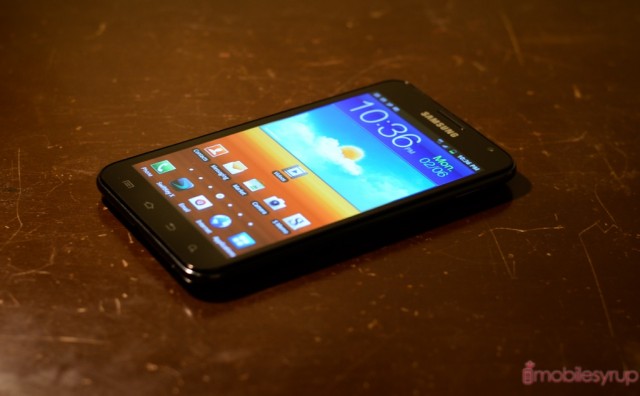
The Galaxy Note’s screen is very bright, even when set to Automatic. Lowering it to around 25% leaves it extremely readable for most indoor activities and saves an hour or so for every charge. So too does turning off LTE, though the battery saving potential is much higher here. After using the Note on Bell’s LTE network for five days, averaging between 8-12 hours depending on what I was doing, I turned it off to test its effect on battery life. The disparity was considerable: whereas on LTE the Note would be almost drained by 6pm (at 25% brightness), on HPSA+ the meter was hovering at 50%. Though there was a considerable drop in network speeds, I’d almost be inclined to suggest, unless LTE speeds are absolutely necessary, to use it on a need-by-need basis.
One also has to keep in mind that despite national availability of LTE devices, the networks themselves (across all three major carriers) are still being deployed, and signal strength is still a big problem. Where I live, just outside Toronto, TELUS, Bell and Rogers have limited LTE penetration. The harder a device has to search for a signal, the more battery life it will eat up attempting to keep it once it’s attained. In many ways, the Note will have improved battery life under LTE when A) the carriers launch their 700Mhz band after the auction and B) more towers are deployed in remote regions to handle increased load.
With a strong LTE signal, and brightness set to Auto, the Note lasted 4 hours 57 minutes looping a 720p video in the Samsung video app.
With a strong HSPA+ signal, and brightness to to Auto, the Note lasted 6 hours 19 minutes looping a 720p video in the Samsung video app.

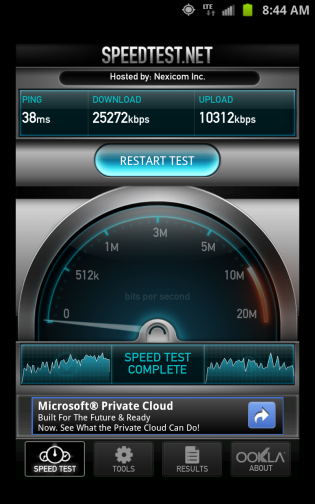
As with any burgeoning network standard, Bell’s LTE network load is currently light, so top speeds are quite high. Unlike HSPA+ networks, LTE can manage very high speeds with 2-3 bars of signal strength, or RSSI levels lower than -100dBm.
On average, I achieved LTE speeds of between 20-30Mpbs download and 6-12Mbps upload, though the results depended heavily on where I was in the GTA and whether I was in- or outside. Since none of the networks are currently using the heavy wall-penetrating 700Mhz band, indoor signal strength tends to suffer. Luckily handover between LTE and HSPA+ is pretty seamless with only a fraction of a second between both.

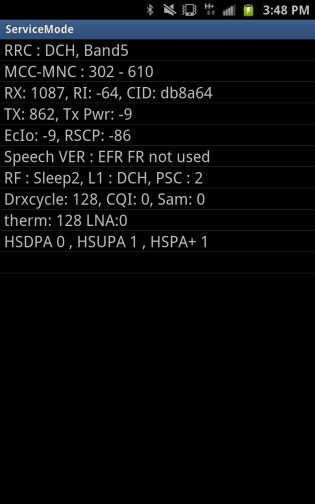
LTE’s advantage on a mobile device shows itself most prominently when combining its superior download speeds with its extraordinarily low latency. This was put into practice when streaming HD video from YouTube, Vimeo, Netflix and Bell’s own Mobile TV app. Whereas on HSPA+ buffering a MB or two would take up to 10 seconds, eating into precious “time wasting” time, over LTE the same video would launch in half a second, at full HD quality.
I’ve spoken at length of LTE’s advantages and disadvantages. It’s really, really fast — at times more so than your home broadband — but that speed comes at the expense of battery life. Luckily turning off LTE and falling back to Bell’s 21Mbps HSPA+ network is effortless, but once you’ve had a taste of the good stuff it’s difficult to go back.
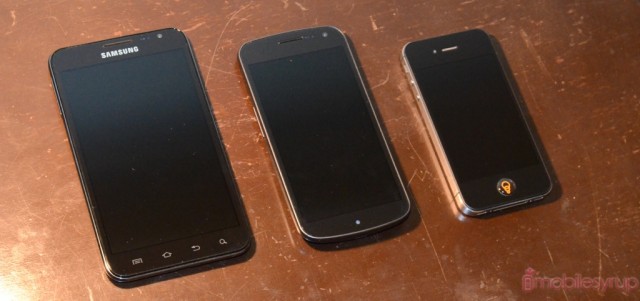
Call, Sound and Speaker Quality and Miscellaneous
The speaker on the back side of the Galaxy Note is loud. It’s also quite vibrant, which is a great deal more than I can say for 99% of the smartphones on the market. Samsung must have understood that the Note would be used as media consumption device, since you can easily fill a room with decent sound from the tiny mono speaker on the back of the device.
The experience of making calls, on the other hand, is merely good. Whether awkwardly holding up the Note to your ear, or connecting through a headset, Bluetooth or otherwise, callers sounded far away to me, and me to them. However, the quality itself is high, with no distracting sibilance, echoes or delays. The Note comes equipped with a second microphone for noise cancellation, though because many of my callers sounded so distant I can’t vouch for its usefulness.
Playing music from the headphones was also a good experience, though as you’ll see in Part 2 of the review Samsung has done little to nothing with the unsightly music app. WiFi, GPS, NFC and all other acronyms worked as expected, with no problems to report. It was nice to find that the Galaxy Note is dual-channel WiFi compatible, and connected to my 5Ghz WiFi network at wired-connection speeds.
The only issue I had with the connectivity was pairing and transferring files between the Note and my MacBook Air. Though the two devices would pair successfully, transferring a file would fail each time it was initiated. Similarly, I could not get my MacBook to “see” the photos on the Note when plugged in using USB using the MTP protocol. WiFi Direct also failed across all devices. Connecting directly to a Windows PC fixed the problem, but considering Google’s own OS X-compatible Android File Transfer app wouldn’t even acknowledge the Note’s existence, I worry for Mac users. There are certainly other ways to connect (WiFi File Explorer Pro!) but the basic methods need to work, period.
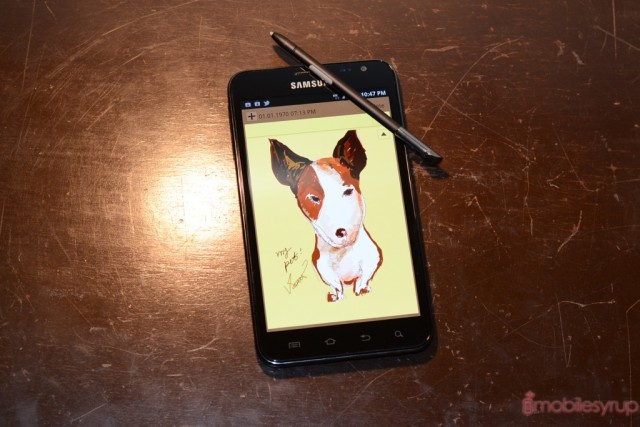
Part One Conclusions
Yes, yes. We haven’t talked about the S-Pen, nor Samsung’s alterations to TouchWIZ 4. That is coming in Part Two.
But if you were to omit the second part, and consider buying the Note on the merits of its “phone” hardware alone, it would be a difficult decision. For starters, the Note is easily the most well-made Galaxy device to date. It has a gorgeous, business-friendly backing, a chrome bezel that is more tasteful than garish, and a stunning 720p screen. It’s hard to find fault in the 5.3-inch HD Super AMOLED display in spite of the PenTile formation; colours are vibrant, blacks are deep and whites more accurate than any previous Samsung device.
Internally things are a bit more same-same. Its 1.5Ghz Snapdragon S3 processor has been used in everything from the Galaxy S II LTE to the Galaxy Tab 8.9 LTE. It mimics much of what made the international Note, with its Exynos, so attractive, but there is evidence that the CPU/GPU combination can’t now, and won’t in the future, be able to keep up with next-generation Android chips. That would be fine if those solutions were coming in six months or a year, but they’re not. Phone with the quad-core Tegra 3 should be available in April or earlier, while Qualcomm’s own S4 chips with built-in LTE are expected no later than June.
One must also consider whether the size of the Note is a barrier for practical, daily enjoyment. Sure, the novelty of a HUGE PHONE might lure you to the cash register, but most people are going to be signing a 3-year contract, and some (gasp!) may even use it for the duration. The wow factor is obvious; less so is the potential for weariness.
As we’ll go over in Part Two, the Galaxy Note is more than just a phone/tablet hybrid. Samsung says the S-Pen is an integral part of the experience and we’ll take a look at whether that’s true, what other goodies the Note has in store, and when we can expect an upgrade to Ice Cream Sandwich.
The Note is available now through TELUS, Bell and Rogers.
MobileSyrup may earn a commission from purchases made via our links, which helps fund the journalism we provide free on our website. These links do not influence our editorial content. Support us here.


